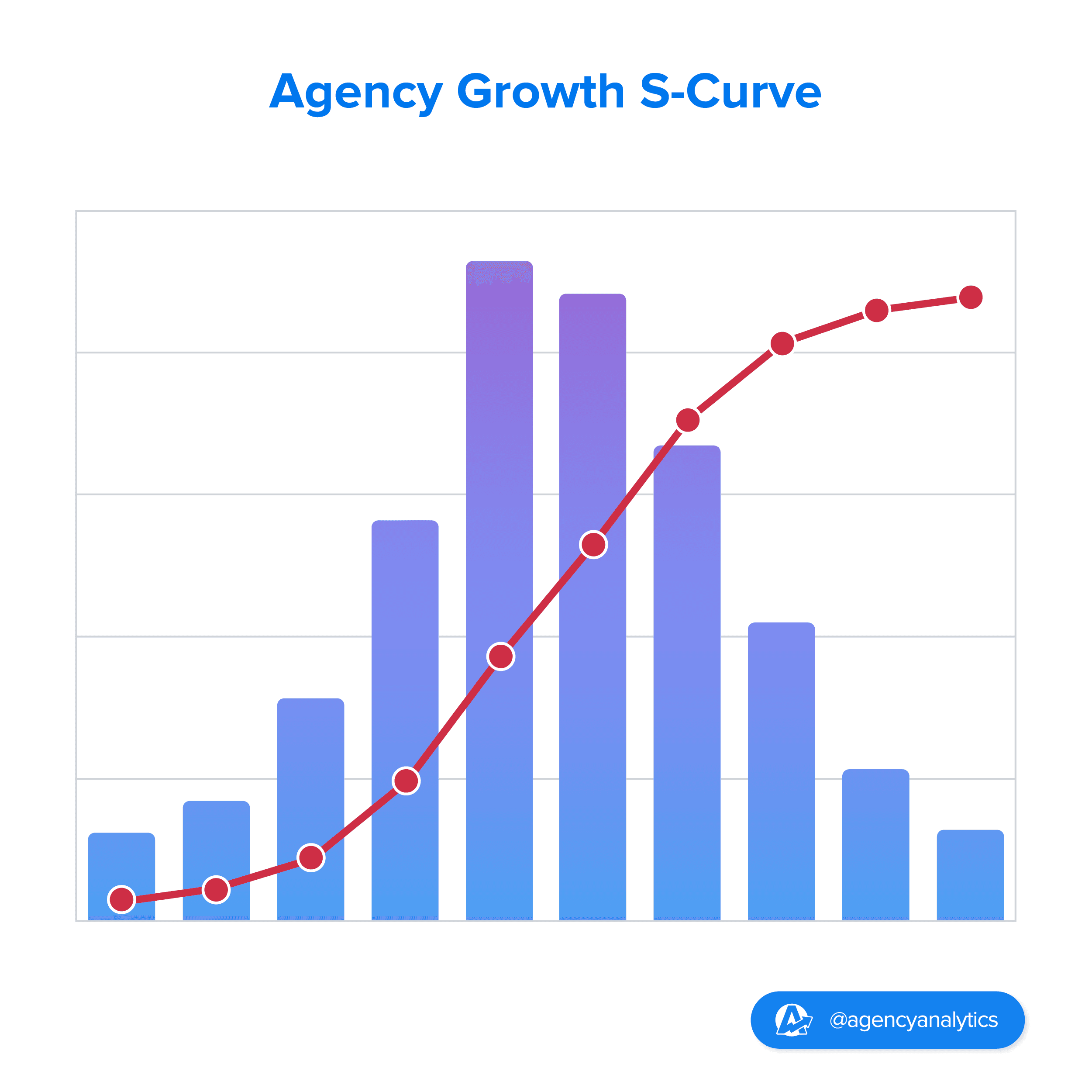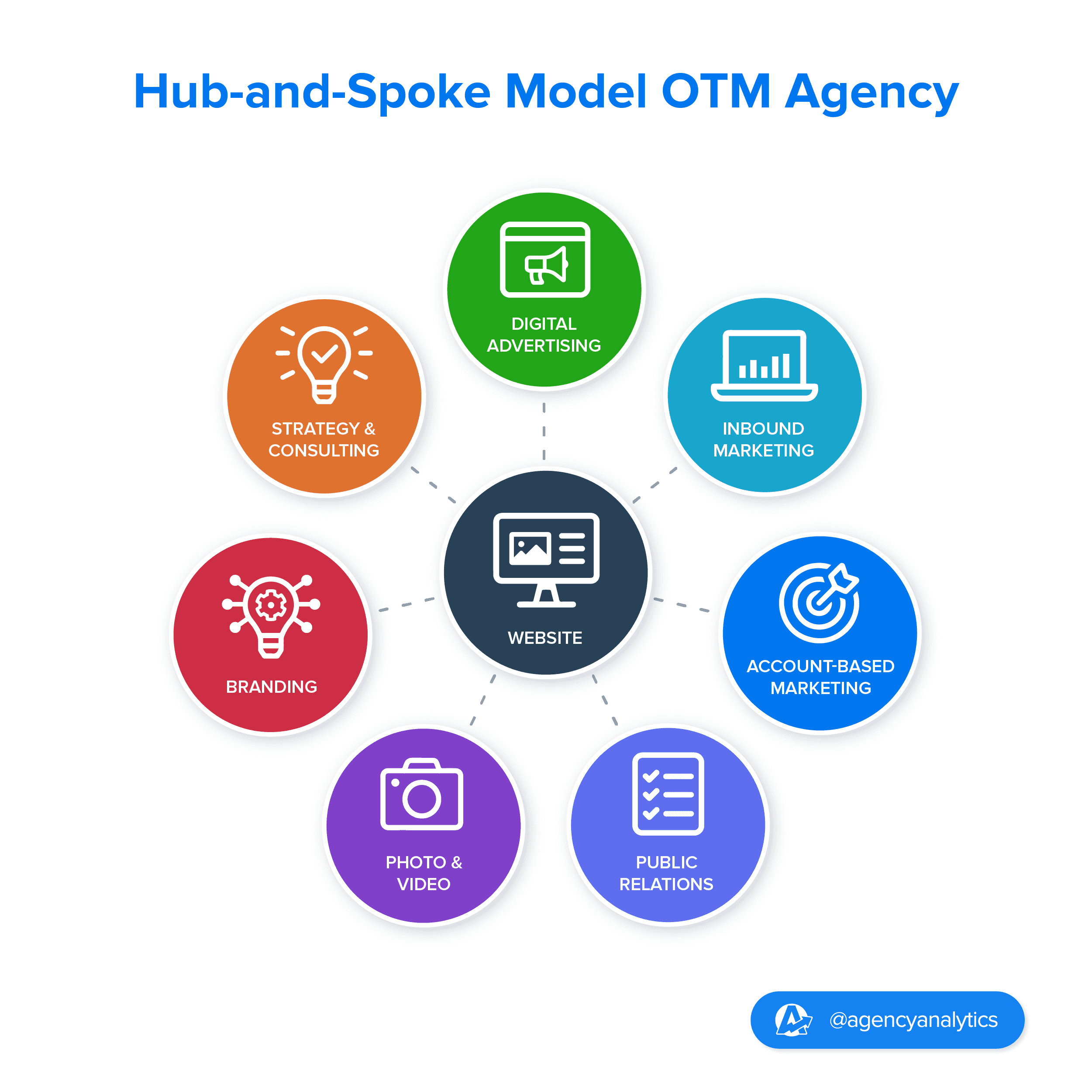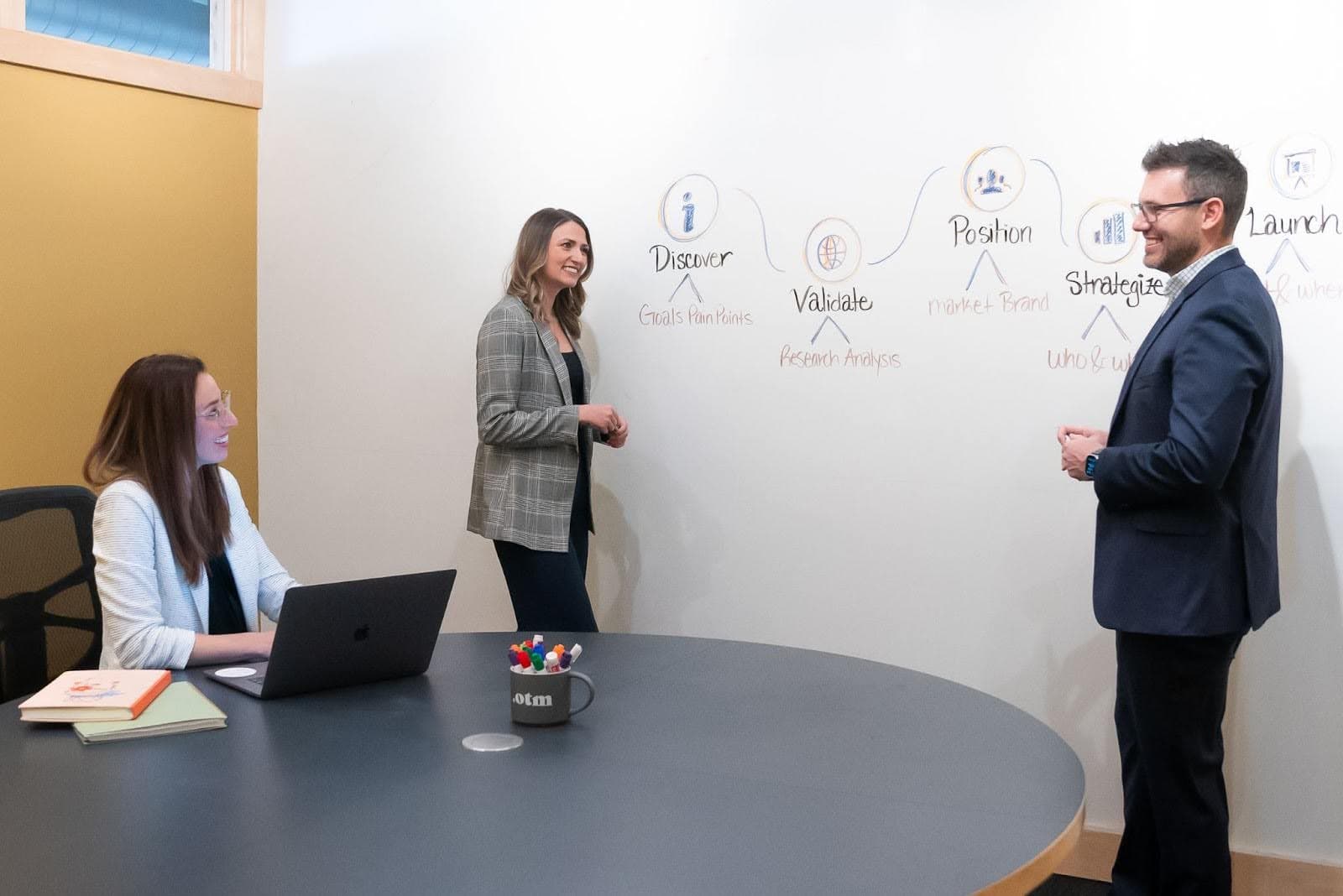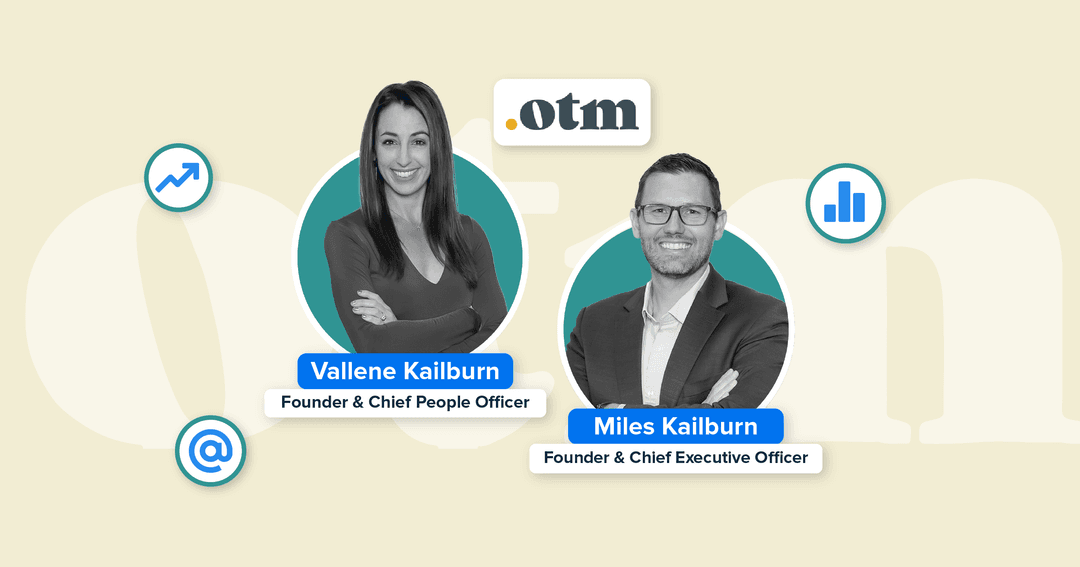Table of Contents
QUICK SUMMARY:
OTM has reinvented itself every seven years since 2007, evolving from a web design shop to a full-service consultancy. Founders Vallene and Miles Kailburn scaled the agency by embracing change, restructuring operations, and investing in tech and leadership. Today, OTM supports 65 clients, focusing on deeper client-side solutions and long-term strategic value.
As the old adage goes, “Necessity is the mother of invention.”
For Miles and Vallene Kailburn, necessity is the mother of re-invention.
In 2004, Vallene and Miles loaded their Chevy S-10 compact pickup and moved to Fort Collins, Colorado. By 2007, Vallene was studying to earn a degree in digital arts, while Miles had taken the vocational route and was focusing on IT and software development.
They soon combined their expertise into what would become Old Town Media (now commonly called OTM).

OTM’s leadership team (left to right): Kerrie Luginbill, Vallene Kailburn, Rachel Schlegel, and Miles Kailburn. (Credit: OTM)
Seventeen years later, OTM has evolved from a small web design shop into a full-service creative consultancy serving some of Northern Colorado’s most prominent businesses. As you’ll soon learn, 17 years is a long time in a modern marketing agency’s lifecycle, and if there’s one thing the Kailburns understand all too well, it’s the need for change to stay ahead of the curve.
Names | Agency | Agency Stats | Location |
|---|---|---|---|
Miles Kailburn Vallene Kailburn | OTM | 16 employees 65 clients Est. 2007 | Fort Collins, USA |
The Seven-Year Agency Reset
For OTM, pivotal changes seem to happen every seven years.
In 2007, Miles and Vallene applied their skills for the same reason other fresh-faced graduates do: They had to pay the bills. For Vallene, that meant taking on every web design project she could, while Miles took on a full-time IT job.
Soon, Miles was assisting Val on the technical side of web design, and the two merged their careers into a fledgling agency.
OTM’s early days were firmly anchored in website development. This was an era when many small businesses were still embarking on the transition to having a digital presence. Creating a website necessitated a specialized and technical skillset involving HTML coding and graphic design. Web development firms were experiencing their heyday.
Throughout this period, OTM designed 150 websites per year, and their services garnered Miles and Vallene about 20 full-time clients comprising solopreneurs, mom-and-pop shops, small businesses, and startups in Fort Collins. Like many agencies in their infancy, OTM’s contracts were mainly acquired through referrals and networking.
It wasn't really meant to be what it is today. It just snowballed from there.
Vallene Kailburn, CPO & Co-Founder, OTM
By 2014, OTM’s team counted roughly 10 employees. They were on the top of their game—that is, until the game changed completely.
The arrival of SaaS platforms like Wix and Squarespace and the democratization of website design meant technological change was catching up to OTM. For a fraction of the price of a custom build, most small businesses could now build their own website in just a few clicks. DIY website building also meant that clients could save on the costs associated with changing web elements like copy and images—small but important billables that acted to keep client accounts alive long-term for many web development firms.
OTM’s first major evolutionary shift was officially on the horizon. It was clear to Miles and Vallene that what worked in 2007 wasn’t a viable long-term plan seven years later. With their core offering becoming obsolete, the agency was forced to diversify its services to remain relevant.
OTM became a full-service marketing company because that's what the industry needed. Anybody could build a website.
Vallene Kailburn, CPO & Co-Founder, OTM
Transforming OTM Into a Full-Service Agency
The web design business that had allowed OTM to grow, hire employees, and build a loyal and resilient customer base had hit a plateau. Miles realized that OTM was now at a critical point on its S-curve.
An S-curve, also known as a sigmoid curve, is a type of curve that shows a growth pattern that starts off slow, then accelerates, and finally slows down again, forming an "S" shape when plotted on a graph.

The S-curve is often used to describe the lifecycle of a product, technology adoption rates, business growth, and biological processes. In the context of running a marketing agency, the S-curve helps visualize business development and expansion over time—from the early phase to growth and, as the curve flattens, maturity.
Miles and Vallene planned to offer new core services on top of their website design expertise, transforming the agency into a full-service operation. Since the strategic pivot, OTM has evolved its portfolio to include digital advertising, inbound marketing, account-based marketing, public relations, photo and video, branding, and strategy and consulting.
To sustain the agency’s momentum during this trying time, Miles and Vallene knew they’d need to expand their leadership team. In 2014, OTM brought on their first full-time marketing director, Kerrie Luginbill (now a partner and OTM’s Chief Growth Officer), and a full-time account director, Rachel Schlegel (now also a partner and OTM’s Chief Relationship Officer).
Miles admits that, for the first few years in its growth phase, new services weren’t fully integrated into OTM’s operations. The pivot had launched fast with the intention to learn and grow along the way, and one critical error the team had made in the process was failing to understand how to create cohesion between the new offering and OTM’s foundational services.
Miles and Vallene had to face a hard truth: They were essentially running two separate companies, and the time management and strategic implications of this oversight prevented them from growing the business to where they wanted it to be.
We just said, ‘We have this little machine running over here that cranks out a bunch of websites, and we'll just put your office over here, and we'll run them that way.’ Lo and behold, we had built two completely vertical silos that were completely disconnected.
There was no cross-selling, there was no co-management. It took us three years to merge those silos together so we could have larger client value lifetime values and a singular point of contact.
Miles Kailburn, CEO & Co-Founder, OTM
To solve their problem, OTM converted its silos into a hub-and-spoke model where all agency services became tied to its core web product, which allowed the agency to upsell clients and cross-sell services.

In a hub-and-spoke model, an ecommerce client might approach the agency for web services and be upsold to an email marketing package. The agency would emphasize to the client the value of email marketing in increasing conversion numbers, touting the benefits of discount codes and flash sales. After seeing the increase in sales on their ecommerce website, that client might be more open to exploring how other services (such as blog content creation or social media) could similarly improve conversions and eventually sign on to expand their contract.
The hub-and-spoke strategy worked like a charm! By 2018, OTM had surpassed $1 million in yearly revenue, and the agency’s client list had grown to more than 30 accounts that included larger enterprise clients, which meant supporting higher marketing goals by working directly with their clients’ executive leaders, including CEOs and CMOs.
To handle the exponential growth they were experiencing, OTM adopted AgencyAnalytics to automate its client reporting. This allowed the agency to scale even further by chopping the time dedicated to client reporting in half.
By the time we made the shift to AgencyAnalytics in 2019, we were spending about 3 hours creating each report on average, resulting in around 105 hours every single month just on reporting.
With AgencyAnalytics, we were able to get that down to around 1.5 hours per report, with almost all of that time dedicated to analysis, saving our team 52.5 hours each month. At our billable rate (which was $115 at the time), that 52.5 hours equated to $6,037.50 in lost revenue each month.
Kerrie Luginbill, CGO, OTM
A Maturing Agency at the Crossroads
Agency life is nothing if not eventful.
Following OTM’s period of rapid expansion came yet more challenges. Today, with 16 fully dedicated employees and 65 clients, OTM finds itself at a crossroads once again.
For OTM, 2023 was a bad year. A year so bad that, in our interview, Vallene recalls her initial reaction: “What the f— is this?”
From a Colorado perspective, Vallene says, OTM is seeing high costs of living mixed with inflation. AI is enabling businesses to bring many core marketing services (content, social, etc.) back in-house rather than having to hire an agency to handle them.
So, agency costs keep getting higher while revenue is stagnant, and raising rates is a limited option because clients are also getting squeezed by soaring operational costs.
Miles explains that, during the COVID years (2020-22), while restaurants and retail stores got hit hard, agencies still managed to grow. If they didn’t, he adds, there was something fundamentally wrong.

Vallene Kailburn, Kerrie Luginbill, and Miles Kailburn develop strategies for OTM. (Credit: OTM)
OTM expected the market to return to 2019 levels in 2023, but that didn’t happen. Instead, the money dried up “because that wasn’t real money, that was stimulus money. That was COVID money. That was PPP (Paycheck Protection Program) money on both ends.”
He adds that, during that time, he saw businesses get sloppy with finances, positioning, and hiring, all while their rates didn’t go up.
2023 was an abysmal year. We talked to many agencies that were down 50%, and some of the best-in-class were flat for the year. It was just kind of a bloodbath for the first three quarters of the year.
Miles Kailburn, CEO & Co-Founder, OTM
What does that mean for OTM and other agencies as they near yet another pivotal moment for change?
Miles and Vallene explain that they, and other agencies like OTM, must now turn to deeper client-side solutions, which could involve:
Re-evaluating and re-designing their agency service lines for efficiency.
Developing clients’ operating models or helping with people systems.
Collaborating with clients’ C-suite executives in a more strategic role.
Do we continue offering these services? It's not a bad thing to ask, ‘Is it creating value or should we take that team and reskill and move them to a new service?’ We're very comfortable in that sense—my background’s in software, where that's relatively been the norm.
When you look into S-curves and the cycles, it literally hits us every seven years—we’re a different company. Somewhere around Year 14, it actually started to make a lot more sense, and we embraced that.
Miles Kailburn, CEO & Co-Founder, OTM
Most importantly, OTM continues to rely on a tech stack that saves time, effort, and money for both the agency and the client.
They’ve built their own “turnkey solution” for managing bottom-of-funnel leads using:
Hubspot (as their CRM and CS platform)
CallRail (for marketing call tracking and analysis)
AgencyAnalytics (for campaign data collection and client reporting)
The questions we get from clients now are more along the lines of operating models and people systems. We’ve built a lot of those things, so I foresee us getting in deeper with the clients and solving more holistic problems that way. I don't know what that looks like yet, but I do find it really exciting, and I find it to be that next level of challenge.
Vallene Kailburn, CPO & Co-Founder, OTM
How Agencies Should Use the S-Curve to Plan Their Next Move
The S-curve helps agencies see where they’re at—whether just starting, growing quickly, or needing to find new ways to keep up the momentum.
OTM's story shows how understanding this curve at the right times helped them make big moves and keep winning. It's a great lesson for other agencies wanting to plan their future steps wisely.
So, where does your agency rank on the S-curve, and what actions will you take next?
Phase | Actions |
|---|---|
Early Phase | Setup and Struggle: The agency is in its infancy, establishing its brand, building a client base, and creating a portfolio. Growth is slow. The agency is relatively unknown and must prove its value to potential clients.
Investing in Resources: The agency invests in skilled professionals, technology, and other resources. These investments don’t always translate into immediate growth. |
Growth Phase | Rapid Client Acquisition: The agency's work begins to speak for itself through successful campaigns and satisfied clients. Word-of-mouth and referrals lead to an increase in business.
Services Expansion: With a growing reputation, the agency expands its services to cater to more diverse marketing needs, further accelerating growth.
Operational Scaling: To handle the increasing workload, the agency hires more staff, adopts new technologies, and improves processes for efficiency. |
Maturity Phase | Market Saturation: Client acquisition slows. The agency has captured a large portion of the available market or faces increased competition from other agencies.
Focus on Retention: Growth slows, and the focus shifts to retaining clients, improving service quality, and offering more value to differentiate from competitors. New markets or niches are explored.
Innovation and Diversification: The agency must adopt new marketing technologies, explore untapped markets, or offer other services outside traditional marketing. |
Building Resiliency and Avoiding Burnout Through Partnerships
Change is a necessity. Change is hard. Change is also exhausting, especially when you both run a company as a couple, and you have two young children.
Asked if there was ever a make-or-break moment that made them reconsider their decision to run OTM over the past 17 years, the founders don’t hesitate to say no. They thank their two business partners, Kerrie Luginbill and Rachel Schlegel, who both joined during OTM’s pivotal growth phase.
I feel very fortunate that we have the partners we do because I've seen a lot of other agencies who are just single owners, and they burned out and quit because they can't do it anymore.
Vallene Kailburn, CPO & Co-Founder, OTM
There have been difficult years for both leaders—2023, especially. However, getting the right partners in OTM’s growth phase enabled Miles and Vallene to have people share the load, avoid burnout, and become stronger.
The Kailburns are all-in on the business, come hell or high water. They’ve built a resilient operation that can adapt to whatever the industry throws at them, and they have the right team to keep driving OTM further.
What matters most to Miles is persistent and incremental improvement. He cites Atomic Habits author James Clear’s compounding 1% improvements as the true measure of success for OTM (or any other agency, for that matter).
We're very relationship-focused. We have a constant focus on innovation. We have very specific client profiles. The whole success aspect of it is persistence and 1% better. We have a 17-year track record of daily wins, and for that reason, we're able to outpace most of our peers in that world.
Miles Kailburn, CEO & Co-Founder, OTM

Written by
Francois Marchand brings more than 20 years of experience in marketing, journalism, and content production. His goal is to equip agency leaders with innovative strategies and actionable advice to succeed in digital marketing, SaaS, and ecommerce.
Read more posts by Francois MarchandSee how 7,000+ marketing agencies help clients win
Free 14-day trial. No credit card required.






